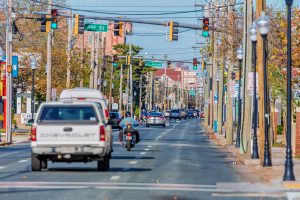
OCEAN CITY — The future of the Baltimore Avenue corridor, largely a gateway to the resort for many via the Route 50 Bridge, was the subject of considerable debate during strategic planning sessions last week.
In recent years, a major renovation of the streetscape along the Baltimore Avenue corridor from North Division Street to 15th Street has been on the town’s radar, but the issue is complicated. On the one hand, the State Highway Administration (SHA) has been systematically milling and repaving sections of Coastal Highway and Philadelphia Avenue heading south in recent years and along the way SHA has been improving sidewalks to make the compliant with federal Americans with Disabilities Act (ADA) standards.
The section of Baltimore Avenue from North Division Street to 15th Street was next in that process and was scheduled to be done two years ago, but the town asked SHA to put it on the back burner while alternatives for renovating that corridor were formalized and the state agency acquiesced. In advance of last week’s strategic planning cram sessions, the Mayor and Council were asked to prioritize their issues and concerns and the Baltimore Avenue renovations made the short list.
The alternatives range from simply doing nothing and allowing SHA to come through and repave the corridor and make the requisite ADA improvements to a complete remodel of the corridor including undergrounding the utilities, thereby eliminating the often-unsightly poles and overhead power lines. The latter has been done successfully in other areas of town, but there is a significant cost associated with it.
Complicating the issue further is the existence of a long forgotten and underutilized right-of-way along the Baltimore Avenue corridor. Baltimore Avenue is somewhat unique in a variety of ways. For example, the original deeds show the right-of-way as 75 feet wide, but the current roadway only utilizes about 45 feet from curb to curb.
Included in the cursory discussion of the streetscape plans was a review of the ancient deeds for Baltimore Avenue that create a no man’s land of about 32 feet in some areas that could ultimately be deeded back to the property owners along the corridor or used to widen the roadway and its sidewalks.
Over the decades, however, private property is steadily encroached on the original right-of-way platted over a century ago. For example, in some cases, private businesses along the corridor have signs in the old right-of-way, while others have parking areas. In some cases, the long-forgotten right-of-way is just covered with grass or landscaping and isn’t necessarily utilized by the private sector.
City Engineer Terry McGean said the right-of-way issue had to be resolved before any real discussion of renovating the corridor could go any further.
“We have 32 feet of additional right-of-way to work with,” he said. “The question is how much of that right-of-way do we want to give back to the property owners.”
McGean said resolving the right-of-way issue didn’t have to be a black and white solution. In some cases, the town could accomplish wider sidewalks and streetscapes by utilizing just some of the right-of-way or all of it.
“It doesn’t have to be all or nothing,” he said. “We could use 16 feet of the right-of-way or all 32 feet, or we don’t use any of it. I just need some direction on what you want to do.”
Another significant issue is the potential undergrounding of the utilities along the corridor. Again, it has been done successfully in other areas of town and greatly improves the aesthetics, but it comes with a significant price tag. McGean said cursory discussions with Delmarva Power alone have resulted in estimates in the $15 million to $20 million range and there are other utilities above ground in the corridor.
“The big question is do you want to underground the utilities?” he said. “If you don’t, there are things we can do in terms of streetscaping and widening sidewalks. We just need some direction so we can begin moving forward.”
Councilman Dennis Dare pointed out when significant undergrounding projects were undertaken in the past, the city’s public works department still had a construction division and much of the work was done in-house.
“In 1991, when we did a lot of utility undergrounding, we did it in-house with our public works department,” he said. “In a cost-saving measure in 2008, we got out of the construction business. We don’t have that capability anymore.”
Dare pointed out the undergrounding of utilities along Baltimore Avenue north of 15th Street, along with other sidewalk widening and streetscaping resulted in a renaissance of sorts along the corridor which helped pay for the projects.
“The redevelopment spurred by that section offset the cost of the project through growth in the tax base,” he said. “We have alleys more attractive than Baltimore Avenue. People come into Ocean City along Baltimore Avenue and it’s their first impression. Undergrounding the utilities is critical. Equally important is what we do with that right-of-way.”

